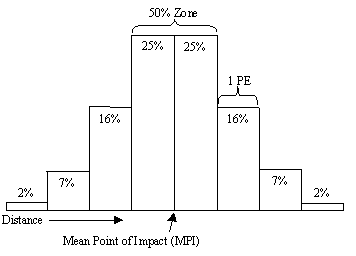Scenario
A Hetzer unit, the first fielded in the East, is in a battle within a large city and must defend against all armor penetrating into the main city area. The main street is 400 meters long and flat. The Hetzer unit have been issued a limited number of APCR rounds to ensure that their combat debut is successful.
Upon arriving in the city, they are warned by the infantry in regards to Soviet Tanks already in the main square up the 400 meter street. The first Hetzer enters the road and turns and faces a Soviet tank several hundred meters up the road directly facing him.
The commander has no time to judge the range and orders "Zone 1, APCR, FIRE!". The gunner immediately sets the elevation to 0.1 degrees, puts his aiming mark at the center of the Soviet tank and fires.
The attached drawing illustrates the following:
Black ellipse is the triple dispersion area (3 x 50% zone of dispersion) for the APCR round if, indeed, the enemy tank is 300 meters away.
Green ellipse shows the triple dispersion area is the enemy tank is 400 meters away. Note it is a larger dispersion and also wider.
The red ellipse is actually the dispersion about the highest point the APCR round would have flown. It is about 150 meters. In other words, any enemy tank between the Hetzer and up to 400 meters has a great probability of being hit.
The triple dispersion of the 50% dispersion gives the area that 99% of the rounds will land.













